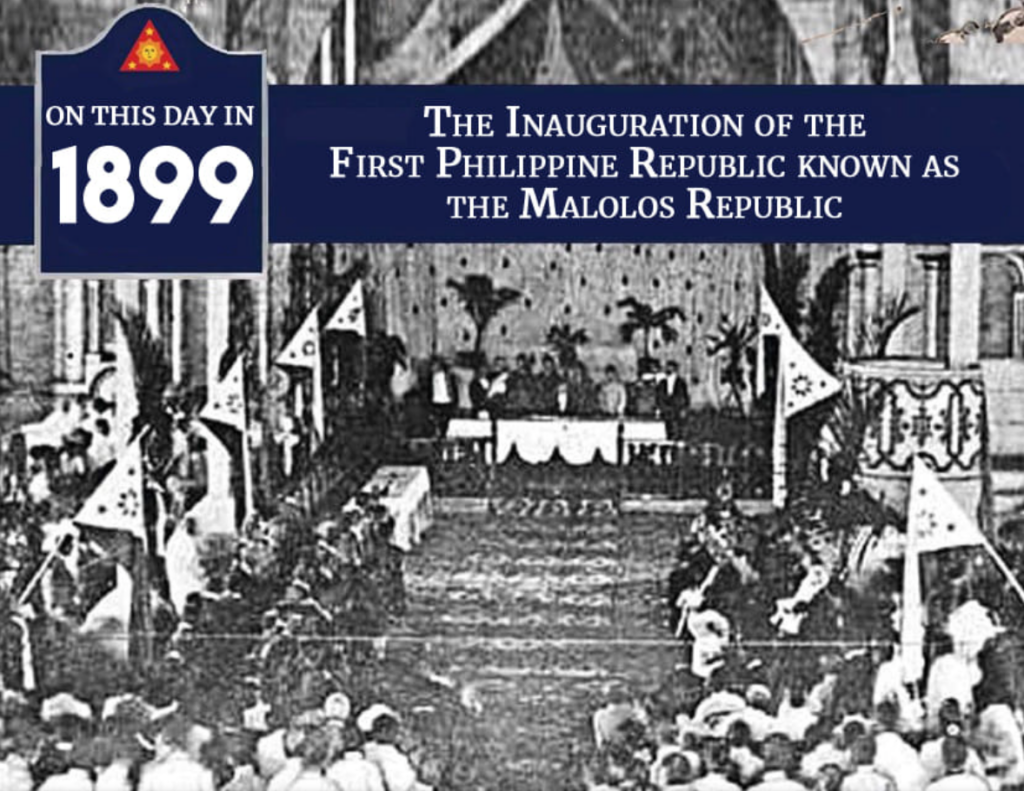The 125th anniversary of the beginning of the Philippine-American War

On January 23, 1899, the First Philippine Republic, also known as the Malolos Republic, was inaugurated at Barasoain Church in Malolos, Bulacan, making the Philippines the first independent republic in Asia. Two weeks later, the Philippine American War began. Image: Legislative Library, Archives and Museum – House of Representatives/Facebook
The year 2024 marks the 125th Anniversary of the Philippine-American War. For most of the 125 years, the war was not even labeled correctly. Americans inaccurately called the war the “Philippine Insurrection.”
In the past fifty years, American historians have expanded historiography of the war. They were able to broaden their analysis of the war. Eventually, they joined Philippine historians and started using the label Philippine-American War. The United States Library of Congress officially reclassified the war in 1999. Since 1999, all references to the war use the Philippine-American War term.
To be appropriately classified as the “Philippine Insurrection” there needed to be a long-established control of the Philippines by the United States. This was not the case. The Americans had only signed the Treaty of Paris, which ceded the Philippines to the United States from Spain, on December 10, 1898. The treaty was not even ratified by the U.S. Senate until after hostilities between American and Filipino forces commenced on February 4, 1899.
There was another reason the war was not an insurrection. The United States only controlled Manila and a few surrounding areas in the Philippines. The forces of Emilio Aguinaldo controlled most of the Philippines. In fact, Aguinaldo was encouraged by the American military and civilian leaders to return to the Philippines from Hong Kong and rally his forces against Spanish rule. The Filipinos and Americans had an informal alliance. The relationship initially benefited both parties, but eventually the alliance collapsed.
When Aguinaldo returned to the Philippines on an American naval vessel, the U.S.S. McCulloch, on May 17, 1898 he was able to regroup his forces against Spanish rule in a very short timeframe. His rebellion against Spain in 1898 and during the Philippine Revolution of 1896 could be classified as an insurrection since Spain had three hundred years of established control of the Philippines. The United States was just a newcomer to the islands.
The month of January 1899 set the stage for a deep fracture between the Filipinos and Americans in early February 1899. When U.S. President William McKinley issued the controversial and potentially volatile Benevolent Assimilation on December 21, 1898, the Military General Elwell Otis delayed the release of the document in Manila until January 4, 1899. General Otis knew the potentially negative impact of the document. He attempted to attenuate and allay the fears of Aguinaldo and other Filipino leaders.
The efforts by General Otis did not work. On January 5, 1899, President Aguinaldo declared a counter proclamation. The document stated that “… most solemnly against his intrusion of the United States Government on the sovereignty of these islands.” When both parties feel differently about who controls sovereignty, a conflict was inevitable.
There were three other issues in January 1899 that were severely straining the relationship between the Filipinos and Americans. General Otis demanded that Emilio Aguinaldo remove his forces from key tactical points along Manila Bay. The Americans still would not permit Filipino soldiers from entering Manila. The Filipino forces had been denied access to Manila since August 13, 1898. Also, Aguinaldo was very concerned with the arrival of fresh American troops in Manila Bay.
Both Otis and Aguinaldo did concur to a peace conference. The conference lasted from January 9, 1899 to January 29, 1899. Both parties sent commissioners to the talks. The conference was a stalemate and unproductive. Aguinaldo thought that the Americans were just buying time for reinforcements.
The drafting of the Philippine Constitution, which began in October 1898, was completed by January 21, 1899. Emilio Aguinaldo approved the constitution. The document was dubbed the Malolos Constitution. The Philippines now had a representative government which insured the rights of Filipinos. The Legislative Branch of government was supreme, and its delegates elected the Executive Branch (President) and the Judicial Branch (Chief Justice of the Supreme Court).
On January 23, 1899, the Philippine Republic was inaugurated in Malolos, Bulacan Province. Emilio Aguinaldo was sworn in during his oath of office for the President of the republic. The event was an enormous celebration with thousands of attendees. The new constitution was read aloud for the audience. The Philippine Army conducted a crisp military procession in the city.
When the fighting begins on February 4, 1899, the conflict was not an insurrection by the Filipinos. At that time, the Philippines was a Constitutional Republic with three separate branches of government. The President, Emilio Aguinaldo, had been elected by the delegates of the Legislative Assembly.
The United States of America was also a Constitutional Republic, although with a longer history of representative government. In January 1899, the United States had significant opposition and dissent to America’s new expansionism and colonial role in the world. Was the former colony ready for the consequences and unintended consequences of being a colonist?
The Philippine-American War was a conflict between two Constitutional Republics not an insurrection. Unfortunately, the needless war cost the lives of approximately 4,200 American soldiers, 16,000 Filipino soldiers, and 200,000 Filipino civilians from diseases and dislocation.
Dennis Edward Flake is the author of three books on Philippine-American history. He is Public Historian and a former seasonal park ranger in interpretation for the National Park Service at the Eisenhower National Historic Site in Gettysburg, PA. He can be contacted at: flakedennis@gmail.com







